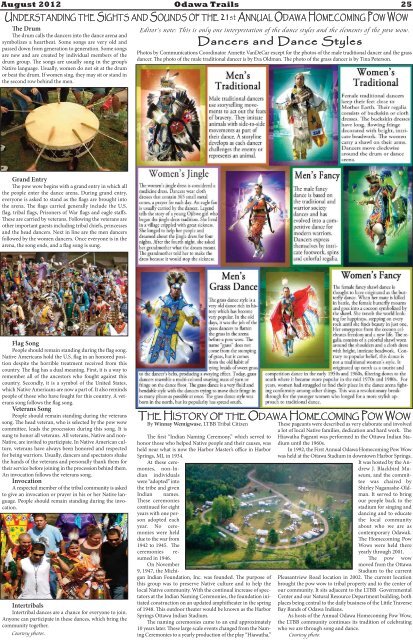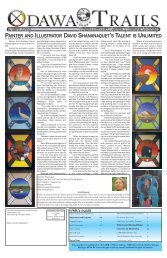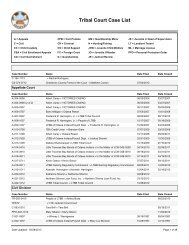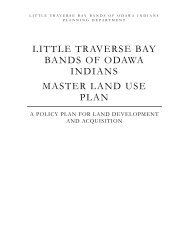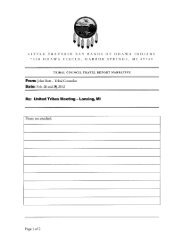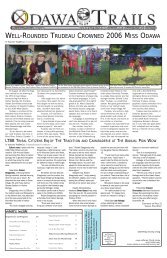August 2012 - Little Traverse Bay Bands of Odawa Indians
August 2012 - Little Traverse Bay Bands of Odawa Indians
August 2012 - Little Traverse Bay Bands of Odawa Indians
Create successful ePaper yourself
Turn your PDF publications into a flip-book with our unique Google optimized e-Paper software.
<strong>August</strong> <strong>2012</strong> <strong>Odawa</strong> Trails<br />
25<br />
UNDERSTANDING THE SIGHTS AND SOUNDS OF THE 21st ANNUAL ODAWA HOMECOMING POW WOW<br />
The Drum<br />
The drum calls the dancers into the dance arena and<br />
symbolizes a heartbeat. Some songs are very old and<br />
passed down from generation to generation. Some songs<br />
are new and are created by individual members <strong>of</strong> the<br />
drum group. The songs are usually sung in the group’s<br />
Native language. Usually, women do not sit at the drum<br />
or beat the drum. If women sing, they may sit or stand in<br />
the second row behind the men.<br />
Grand Entry<br />
The pow wow begins with a grand entry in which all<br />
the people enter the dance arena. During grand entry,<br />
everyone is asked to stand as the flags are brought into<br />
the arena. The flags carried generally include the U.S.<br />
flag, tribal flags, Prisoners <strong>of</strong> War flags and eagle staffs.<br />
These are carried by veterans. Following the veterans are<br />
other important guests including tribal chiefs, princesses<br />
and the head dancers. Next in line are the men dancers<br />
followed by the women dancers. Once everyone is in the<br />
arena, the song ends, and a flag song is sung.<br />
Flag Song<br />
People should remain standing during the flag song.<br />
Native Americans hold the U.S. flag in an honored position<br />
despite the horrible treatment received from this<br />
country. The flag has a dual meaning. First, it is a way to<br />
remember all <strong>of</strong> the ancestors who fought against this<br />
country. Secondly, it is a symbol <strong>of</strong> the United States,<br />
which Native Americans are now a part <strong>of</strong>. It also reminds<br />
people <strong>of</strong> those who have fought for this country. A veterans<br />
song follows the flag song.<br />
Veterans Song<br />
People should remain standing during the veterans<br />
song. The head veteran, who is selected by the pow wow<br />
committee, leads the procession during this song. It is<br />
sung to honor all veterans. All veterans, Native and non-<br />
Native, are invited to participate. In Native American culture,<br />
veterans have always been honored and respected<br />
for being warriors. Usually, dancers and spectators shake<br />
the hands <strong>of</strong> the veterans and personally thank them for<br />
their service before joining in the procession behind them.<br />
An invocation follows the veterans song.<br />
Invocation<br />
A respected member <strong>of</strong> the tribal community is asked<br />
to give an invocation or prayer in his or her Native language.<br />
People should remain standing during the invocation.<br />
Intertribals<br />
Intertribal dances are a chance for everyone to join.<br />
Anyone can participate in these dances, which bring the<br />
community together.<br />
Courtesy photos.<br />
Editor’s note: This is only one interpretation <strong>of</strong> the dance styles and the elements <strong>of</strong> the pow wow.<br />
Dancers and Dance Styles<br />
Photos by Communications Coordinator Annette VanDeCar except for the photos <strong>of</strong> the male traditional dancer and the grass<br />
dancer. The photo <strong>of</strong> the male traditional dancer is by Eva Oldman. The photo <strong>of</strong> the grass dancer is by Tina Peterson.<br />
THE HISTORY OF THE ODAWA HOMECOMING POW WOW<br />
By Winnay Wemigwase, LTBB Tribal Citizen<br />
The first “Indian Naming Ceremony,” which served to<br />
honor those who helped Native people and their causes, was<br />
held near what is now the Harbor Master’s <strong>of</strong>fice in Harbor<br />
Springs, MI, in 1934.<br />
At these ceremonies,non-Indian<br />
individuals<br />
were “adopted” into<br />
the tribe and given<br />
Indian names.<br />
These ceremonies<br />
continued for eight<br />
years with one person<br />
adopted each<br />
year. No ceremonies<br />
were held<br />
due to the war from<br />
1942 to 1945. The<br />
ceremonies resumed<br />
in 1946.<br />
On November<br />
9, 1947, the Michigan<br />
Indian Foundation, Inc. was founded. The purpose <strong>of</strong><br />
this group was to preserve Native culture and to help the<br />
local Native community. With the continual increase <strong>of</strong> spectators<br />
at the Indian Naming Ceremonies, the foundation initiated<br />
construction on an updated amphitheater in the spring<br />
<strong>of</strong> 1948. This outdoor theater would be known as the Harbor<br />
Springs Ottawa Indian Stadium.<br />
The naming ceremonies came to an end approximately<br />
10 years later. These large scale events changed from the Naming<br />
Ceremonies to a yearly production <strong>of</strong> the play “Hiawatha.”<br />
These pageants were described as very elaborate and involved<br />
a lot <strong>of</strong> local Native families, dedication and hard work. The<br />
Hiawatha Pageant was performed in the Ottawa Indian Stadium<br />
until the 1960s.<br />
In 1992, the First Annual <strong>Odawa</strong> Homecoming Pow Wow<br />
was held at the Ottawa Stadium in downtown Harbor Springs.<br />
It was hosted by the Andrew<br />
J. Blackbird Museum,<br />
and the committee<br />
was chaired by<br />
Shirley Naganashe-Oldman.<br />
It served to bring<br />
our people back to the<br />
stadium for singing and<br />
dancing and to educate<br />
the local community<br />
about who we are as<br />
contemporary <strong>Odawa</strong>k.<br />
The Homecoming Pow<br />
Wows were held there<br />
yearly through 2001.<br />
The pow wow<br />
moved from the Ottawa<br />
Stadium to the current<br />
Pleasantview Road location in 2002. The current location<br />
brought the pow wow to tribal property and to the center <strong>of</strong><br />
our community. It sits adjacent to the LTBB Governmental<br />
Center and our Natural Resource Department building, both<br />
places being central to the daily business <strong>of</strong> the <strong>Little</strong> <strong>Traverse</strong><br />
<strong>Bay</strong> <strong>Bands</strong> <strong>of</strong> <strong>Odawa</strong> <strong>Indians</strong>.<br />
As hosts <strong>of</strong> the Annual <strong>Odawa</strong> Homecoming Pow Wow,<br />
the LTBB community continues its tradition <strong>of</strong> celebrating<br />
who we are through song and dance.<br />
Courtesy photo.


